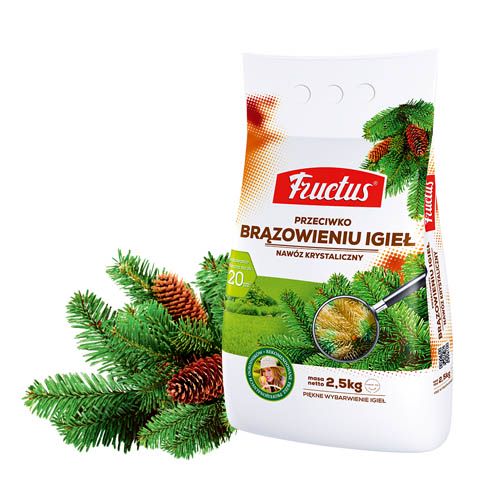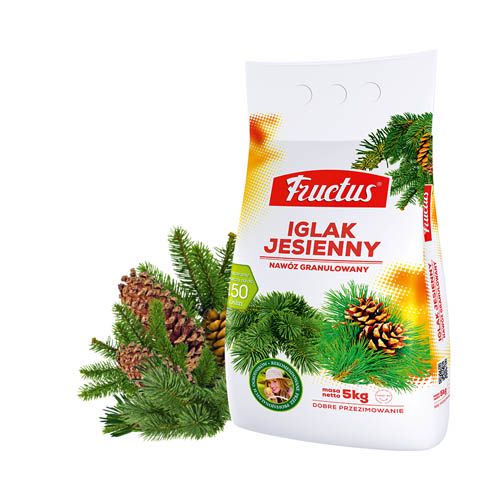Advice
Cultivation of conifers
When setting up a garden it is most important to have a well-thought-out design, vision and objectives. While planning its arrangement we should try to do it in such a way so as to make the garden attractive in different seasons of the year, including winter. Let us not forget about evergreen plants which include the most popular conifers. Coniferous trees and shrubs are one of the most beautiful ornamental plants.
more
SELECTION OF CONIFERS
The success of cultivation depends on the quality of purchased products and planned garden concept. Therefore, it is important to properly select varieties, appropriate to the place of future exposure, for example, varieties that are the background for other species that like shaded areas or are the enclave for creeping plants. It is a common mistake that we select varieties we really like, but we know little about. As a result, it can appear that the purchased plant does not meet our expectations, e.g. is too sensitive to low temperatures and requires a completely different climate conditions.
SUBSTRATE PREPARATION
It often happens that despite acting in accordance with the art of gardening and large expenditures incurred for treatment of conifers, instead of developing, they diminish in our eyes. This is because most of our soils are alkaline earths unsuitable for planting conifers. Conifers best take root in areas slightly acidic, so it is necessary to change the pH reaction of the soil. This can be achieved by using a ready-made substrate for conifers which provides a suitable pH, good structure and promotes the development of symbiotic microorganisms, as in the natural forest environment. For acidification an acidic fertilizer can be applied e.g. Fructus Conifer, optionally peat.
PLANTING CONIFERS
Once you have made the right choice of trees and shrubs, with extreme caution, planting should be started. The first and most common mistake is the excessive concentration of plants in a small space. The phenomenon seems natural, since the purchased young material is relatively small, the prospect of full growth is far away and there is so much space around that we begin to arrange the plants too close to one another. After a few years, all grow into one another and even cutting does not help to restore the aesthetics of the place. We need to be aware that the decoration of the garden is a process that takes several or dozen years and even, as some say, a life time.
Let us strive to buy coniferous plants together with root balls, because they are the best material for planting throughout the vegetation period. After removing the plant from the container, we must pay a special attention to the root system and, if necessary, remove all the rotten rootlets or damaged tips using pruning shears. The plant must be planted in such a way that the neck root (thickening visible on the main stem) is positioned flush with the surface of the ground. The free space in the previously dug hole should be best filled with specialist substrate kneading well.
Plants without root ball should be placed so that the roots are not tucked up. When planting conifers in spring, it is worth to form a slight depression from earth around the plant (in the shape of a bowl), so that water during rain or watering goes directly into the root zone. Autumn planting is associated with the need to protect young plants from frost. Screens are made of natural materials, such as nonwoven fabric, corrugated paper, straw. After planting, the plant should be watered abundantly to create mud, it will fill the voids at the roots with water, which pushes air bubbles up, protecting the root system before rotting processes.
FERTILIZATION
Healthy and unique look of our conifers depends largely on their skilful fertilization. With this purpose, we recommend a perfectly balanced, enriched with micro-nutrients mineral fertilizer Fructus Conifer. It contains iron and magnesium ensuring juicy full colors of fertilized plants, while other micronutrients ensure their sustainable growth and development as well as adequate winter-hardiness. In the case of coniferous plants use of this fertilizer prevents needle browning. The granulate form and adequate composition cause that components are gradually released, so that the fertilizer has a long duration of action.
Fructus Conifer can be used in gardens and parks in the period from early spring to late August. It is recommended to split the annual dose in the amount of 0.8-1.0 kg / 10 m2 into two parts – the first one to be applied together with starting of the spring vegetation and the second in June-August period. We spread the fertilizer evenly within a radius a little bigger than the outline of the crown of the tree or shrub. After the procedure, the fertilized surface should be watered with a sufficient amount of water.
In late autumn, we recommend the fertilizer called Fructus Autumn. It is a phosphorus-potassium fertilizer with micronutrients without nitrogen content, thanks to which it better prepares our plants to overwintering.
WEED
Conifers should be kept in a soil in which the surface around the trunks is weeded, not planted with grass or other cover crops. In this way, we ensure proper aeration of plants, irrigation and nutrient uptake. The substrate can be weeded in a mechanical way by digging the soil at a reasonable depth with a small fork or spade and choosing carefully all rhizomes and underground weed runners without damaging the root system of our plants. We can also use commercially available herbicides. In this case, however, it is essential to follow the instructions on the package. Improper use of these agents can seriously damage our conifers.
MULCHING
Mulching the soil directly under the trees prevents the growth of weeds and reduces water evaporation. Currently, it is a very commonly recommended treatment. For this purpose we most often use peat or pine bark. Mulching should be made with a layer with a thickness of 5 cm.
TRIMMING CONIFERS
Cutting coniferous plants need not be a treatment performed systematically. For species that produce the so-called arrow (straight trunk), e.g. firs and spruces, cutting should be limited only to the removal of competing leaders. Also, self-forming varieties and dwarf plants should not be cut. It is relatively simple to cut thuyas, junipers, yews, pines and cypresses. We carry out the first cutting after the winter period in late spring, after remission of frost wave to remove branches that are damaged and infected by a disease – it is a sanitary cutting.
In summer we can carry out so-called shaping cutting, however, this procedure should be done by a person who has experience in similar activities. This prevents unwanted errors. While forming a crown of conifers with other than creeping habit you have to remember that it must be as wide as possible at the base – this will ensure access of light and thus prevent falling of needles on the lower branches. Never make cuts later than in August (except for dense hedges) because we can thus lead to freezing of shoots.
FINAL ADVICE
Let us not plant deciduous plants very close to conifers, as they can bump their twigs, cause falling of needles and cause damage to the shoots. It is important also to prepare the plants for the winter period by binding column and egg-shaped forms, which protects them from fracturing by snow. In the event that we have a dog and are planning to plant a hedge, we need to separate a space between the fence and conifer row for the animal so that it can run without corrupting our plants.
TREATMENT RECOMMENDATIONS FOR CONIFERS:
Fructus IGLAK I INNE ROŚLINY KWAŚNOLUBNE (Fructus CONIFER AND OTHER ACID-LOVING PLANTS)
| 2,5kg | 5kg | 10kg | 25kg |
Fructus IGLAK JESIENNY (Fructus AGAINST NEEDLE BROWNING )
| 5kg | 10kg |
SHOW ALL PRODUCTS FOR CONIFER TREATMENT
- Fructus Nawóz do iglaków (Fructus fertilizer for conifers) – granules
- Fructus Iglak i inne rośliny kwaśnolubne (Fructus Conifer and other acid) – granules
- Fructus Nawóz przeciwko brązowieniu igieł (Fructus fertilizer against needle) – granules
- Fructus Przeciwko brązowieniu igieł (Fructus against needle browning ) – granules
- Fructus Nawóz jesienny do iglaków (Fructus Autumn fertilizer for conifers) – granules
- Fructus Iglak jesienny (Fructus Conifer Autumn) – granules






